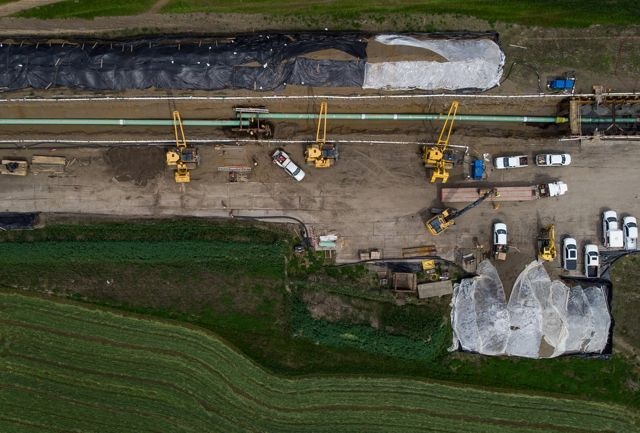Energy
First Nation wants reasons for Trans Mountain ruling; says it’s entitled to appeal

In this photograph taken with a drone, workers lay pipe during construction of the Trans Mountain pipeline expansion on farmland, in Abbotsford, B.C., on Wednesday, May 3, 2023. A B.C. First Nation is asking the Canada Energy Regulator to release its reasons as soon as possible for allowing a modification of the Trans Mountain pipeline’s route.THE CANADIAN PRESS/Darryl Dyck
By Amanda Stephenson in Calgary
A B.C. First Nation is asking the Canada Energy Regulator to release its reasons as soon as possible for allowing a modification of the Trans Mountain pipeline’s route.
In a letter to the regulator dated Wednesday, a lawyer representing the Stk’emlúpsemc te Secwépemc Nation (SSN) said the decision to grant the route deviation Monday without providing its reasons has left the First Nation without the ability to decide its next steps.
The letter said the First Nation has the right to request a reconsideration of the decision, or to appeal it through the Federal Court of Appeal.
“This has, in fact, created significant uncertainty for SSN and left SSN without the procedural options that would otherwise be afforded to it with the potential for irreparable harm to its rights and title as a result,” the letter states.
The Canada Energy Regulator ruled Monday to allow Trans Mountain Corp. to alter the route slightly for a 1.3-kilometre stretch of pipeline in the Jacko Lake area near Kamloops, B.C.
It said it would release its reasons for the decision in the coming weeks.
Trans Mountain Corp, a Crown corporation, had requested the change because of what it said were engineering difficulties in the area related to the construction of a tunnel.
The company had warned that being forced to stick to its original route and construction method could result in up to a nine-month delay in the pipeline’s completion, as well as an additional $86 million more in project costs.
Trans Mountain had been hoping to have the pipeline completed by early 2024.
But the Stk’emlúpsemc te Secwépemc Nation, whose traditional territory the pipeline crosses and who had only agreed to the originally proposed route, opposed Trans Mountain’s application.
The First Nation has said the new route threatens to disturb land that has spiritual and cultural significance.
The First Nation’s lawyer said in the letter Wednesday that Trans Mountain has indicated it wants to break ground on the new route on Oct. 2.
The Trans Mountain pipeline is Canada’s only pipeline system transporting oil from Alberta to the West Coast. The expansion, which is currently underway, will boost the pipeline’s capacity to 890,000 barrels per day (bpd) from 300,000 bpd.
The pipeline — which was bought by the federal government for $4.5 billion in 2018 after previous owner Kinder Morgan Canada Inc. threatened to scrap the expansion project in the face of environmentalist opposition and regulatory hurdles — has already been plagued by construction-related challenges and delays.
Its projected price tag has also soared: first to $12.6 billion, then to $21.4 billion and most recently to $30.9 billion.
This report by The Canadian Press was first published Sept. 28, 2023.
Alberta
Pierre Poilievre – Per Capita, Hardisty, Alberta Is the Most Important Little Town In Canada

From Pierre Poilievre
Energy
If Canada Wants to be the World’s Energy Partner, We Need to Act Like It

Photo by David Bloom / Postmedia file
From Energy Now
By Gary Mar
With the Trans Mountain Expansion online, we have new access to Pacific markets and Asia has responded, with China now a top buyer of Canadian crude.
The world is short on reliable energy and long on instability. Tankers edge through choke points like the Strait of Hormuz. Wars threaten pipelines and power grids. Markets flinch with every headline. As authoritarian regimes rattle sabres and weaponize supply chains, the global appetite for energy from stable, democratic, responsible producers has never been greater.
Canada checks every box: vast reserves, rigorous environmental standards, rule of law and a commitment to Indigenous partnership. We should be leading the race, but instead we’ve effectively tied our own shoelaces together.
In 2024, Canada set new records for oil production and exports. Alberta alone pumped nearly 1.5 billion barrels, a 4.5 per cent increase over 2023. With the Trans Mountain Expansion (TMX) online, we have new access to Pacific markets and Asia has responded, with China now a top buyer of Canadian crude.
The bad news is that we’re limiting where energy can leave the country. Bill C-48, the so-called tanker ban, prohibits tankers carrying over 12,500 tons of crude oil from stopping or unloading crude at ports or marine installations along B.C.’s northern coast. That includes Kitimat and Prince Rupert, two ports with strategic access to Indo-Pacific markets. Yes, we must do all we can to mitigate risks to Canada’s coastlines, but this should be balanced against a need to reduce our reliance on trade with the U.S. and increase our access to global markets.
Add to that the Impact Assessment Act (IAA) which was designed in part to shorten approval times and add certainty about how long the process would take. It has not had that effect and it’s scaring off investment. Business confidence in Canada has dropped to pandemic-era lows, due in part to unpredictable rules.
At a time when Canada is facing a modest recession and needs to attract private capital, we’ve made building trade infrastructure feel like trying to drive a snowplow through molasses.
What’s needed isn’t revolutionary, just practical. A start would be to maximize the amount of crude transported through the Trans Mountain Expansion pipeline, which ran at 77 per cent capacity in 2024. Under-utilization is attributed to a variety of factors, one of which is higher tolls being charged to producers.
Canada also needs to overhaul the IAA and create a review system that’s fast, clear and focused on accountability, not red tape. Investors need to know where the goalposts are. And, while we are making recommendations, strategic ports like Prince Rupert should be able to participate in global energy trade under the same high safety standards used elsewhere in Canada.
Canada needs a national approach to energy exporting. A 10-year projects and partnerships plan would give governments, Indigenous nations and industry a common direction. This could be coupled with the development of a category of “strategic export infrastructure” to prioritize trade-enabling projects and move them through approvals faster.
Of course, none of this can take place without bringing Indigenous partners into the planning process. A dedicated federal mechanism should be put in place to streamline and strengthen Indigenous consultation for major trade infrastructure, ensuring the process is both faster and fairer and that Indigenous equity options are built in from the start.
None of this is about blocking the energy transition. It’s about bridging it. Until we invent, build and scale the clean technologies of tomorrow, responsibly produced oil and gas will remain part of the mix. The only question is who will supply it.
Canada is the most stable of the world’s top oil producers, but we are a puzzle to the rest of the world, which doesn’t understand why we can’t get more of our oil and natural gas to market. In recent years, Norway and the U.S. have increased crude oil production. Notably, the U.S. also increased its natural gas exports through the construction of new LNG export terminals, which have helped supply European allies seeking to reduce their reliance on Russian natural gas.
Canada could be the bridge between demand and security, but if we want to be the world’s go-to energy partner, we need to act like it. That means building faster, regulating smarter and treating trade infrastructure like the strategic asset it is.
The world is watching. The opportunity is now. Let’s not waste it.
Gary Mar is president and CEO of the Canada West Foundation
-

 Crime2 days ago
Crime2 days agoNational Health Care Fraud Takedown Results in 324 Defendants Charged in Connection with Over $14.6 Billion in Alleged Fraud
-

 Health2 days ago
Health2 days agoRFK Jr. Unloads Disturbing Vaccine Secrets on Tucker—And Surprises Everyone on Trump
-

 Business1 day ago
Business1 day agoElon Musk slams Trump’s ‘Big Beautiful Bill,’ calls for new political party
-

 International21 hours ago
International21 hours agoCBS settles with Trump over doctored 60 Minutes Harris interview
-

 Business13 hours ago
Business13 hours agoLatest shakedown attempt by Canada Post underscores need for privatization
-

 Business13 hours ago
Business13 hours agoWhy it’s time to repeal the oil tanker ban on B.C.’s north coast
-

 Censorship Industrial Complex1 day ago
Censorship Industrial Complex1 day agoGlobal media alliance colluded with foreign nations to crush free speech in America: House report
-

 Aristotle Foundation21 hours ago
Aristotle Foundation21 hours agoHow Vimy Ridge Shaped Canada






